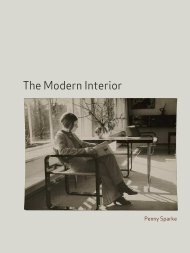Landscape Architecture: Landscape Architecture: - School of ...
Landscape Architecture: Landscape Architecture: - School of ...
Landscape Architecture: Landscape Architecture: - School of ...
- No tags were found...
Create successful ePaper yourself
Turn your PDF publications into a flip-book with our unique Google optimized e-Paper software.
Patricia Johanson, Fair Park Lagoon, Dallas, Texas, 1981<br />
This once environmentally degraded lagoon became a functioning ecosystem when the artist created new concrete<br />
edges and bridges shaped like native plants. She planted bulrushes, wild rice and tall grasses that root in shallow<br />
water along the shoreline to provide shelter and food for small animals and birds and, further out, added water lilies<br />
and irises surrounded by a causeway shaped like the tip <strong>of</strong> the fern. Paths for people are based on the twisted roots <strong>of</strong><br />
the delta duck-potato; thinner stems rise out <strong>of</strong> the water to provide perches for birds. Leaf-like elements towards the<br />
centre <strong>of</strong> the lagoon form safe islands for animals; other ‘leaves’ along the shore create step seating and overlooks.<br />
turned into “community gardens” were initiated by artists<br />
as a kind <strong>of</strong> guerilla act.’<br />
Patricia Johanson’s land and water sculptures, such as the<br />
Fair Park Lagoon in Dallas (1981), were particularly prescient<br />
since they restored the ecological balance while transforming<br />
watery edges into usable places shaped like the flora and<br />
fauna around them. Johanson, who proposed sculptural<br />
solutions to environmental problems as early as 1969, is an<br />
artist with a degree in architecture (earned in order to help<br />
get her projects built). But there were other landscape<br />
architects at that time, such as Lawrence Halprin in San<br />
Francisco and Richard Haag in Seattle, who also did lively,<br />
usable, transformative urban projects that foreshadow those<br />
being done today. Haag converted a brownfield site long<br />
before the term was in popular usage.<br />
Today, abandoned industrial sites are the most likely<br />
places for public works <strong>of</strong> landscape architecture, and they<br />
take a bizarre variety <strong>of</strong> forms from waterfronts and railroad<br />
beds to mines and factories. In New York City, the 2.4-<br />
kilometre (1 1 / 2 -mile) elevated High Line railroad track which<br />
stopped carrying freight 26 years ago, and the 898-hectare<br />
(2,220-acre) Fresh Kills landfill on Staten Island – a massive<br />
pile <strong>of</strong> garbage that rises to 69 metres (225 feet) at some<br />
points and is visible from the moon – are both being<br />
transformed by James Corner’s Field Operations.<br />
The Fresh Kills site – an intertidal marsh into which 150<br />
million tons <strong>of</strong> refuse, mostly household waste, was dumped for<br />
over half a century – managed to grow forests, create a nesting<br />
area for herons, and host migrating birds anyway, though it<br />
<strong>of</strong>ten emitted foul odours. In 2001, plans for its conversion to a<br />
park had been made, a competition held, and closing begun,<br />
when events on 11 September forced it to reopen to<br />
accommodate debris from the World Trade Center tragedy,<br />
giving new ironic meaning to its name, which had actually<br />
come from the Fresh Kills Estuary. Finally, however, design<br />
development has begun, construction will start next year, and<br />
the first $150 million phase <strong>of</strong> the project will open in 2008.<br />
Service roads will be turned into public thoroughfares,<br />
easing traffic congestion on Staten Island and making the<br />
park accessible by car. A gateway flanked by wind turbines<br />
will lead to four landfill mounds, each capped and<br />
transformed into a different landscape. The one on the north<br />
will have a rounded peak with meadows, but there will also be<br />
woods, secluded island nesting areas, marshes with an<br />
interpretive centre, and a memorial garden to those whose<br />
remains lie within the land. There will be ball fields, boating<br />
and fishing, picnic spots, horse trails and a great lawn for<br />
events. The Point will have a dock for a ferry from<br />
Manhattan’s Battery Park with a promenade <strong>of</strong> restaurants,<br />
art installations and outdoor markets at the water’s edge.<br />
Corner calls the whole place a ‘Lifescape’ that will transform<br />
suburban Staten Island from ‘a backyard bypass in a larger<br />
and more vital metropolis’ into ‘a nature-lifestyle island, a big<br />
spread <strong>of</strong> lush vegetation, open space, birds, mammals and<br />
amphibians – an expansive network <strong>of</strong> greenways,<br />
recreational areas and restored habitat reserves.’<br />
The High Line’s less charged history will be more visibly<br />
preserved when it is turned into an open-air walkway two<br />
38



